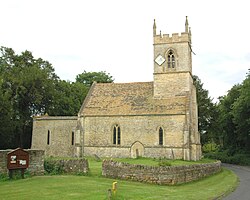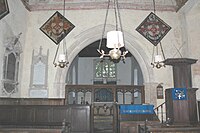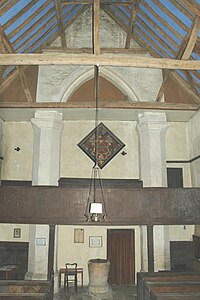Woodeaton
| Woodeaton | |
| Oxfordshire | |
|---|---|
 Holy Rood, Woodeaton | |
| Location | |
| Grid reference: | SP535121 |
| Location: | 51°48’18"N, 1°13’30"W |
| Data | |
| Population: | 80 (2001) |
| Post town: | Oxford |
| Postcode: | OX3 |
| Dialling code: | 01865 |
| Local Government | |
| Council: | South Oxfordshire |
| Parliamentary constituency: |
Henley |
Woodeaton or Wood Eaton is a village in Oxfordshire, about four miles north-east of Oxford.
Parish church
Woodeaton has had a parish church since the early or middle part of the 11th century.[1] The present parish church, Holy Rood, originates from an early Norman stone church that was built between 1070 and 1120.[2]
Several Early Gothic lancet windows in the chancel also date from this period. The nave was rebuilt in about 1250–1300.[3] Later in the Middle Ages, the east and south walls of the chancel were rebuilt and were given late Perpendicular Gothic windows.[3] The eastern window in the south wall of the nave was also revised with Perpendicular tracery.[3] The Perpendicular Gothic belltower was added in either the 14th[4][5] or 15th century.[6] Unusually the tower is built on columns erected inside the nave. This seems to be because the ground falls away west of the church to an extent that precluded building a tower conventionally to the west of the nave.[3] The south porch was built in the 18th century.[6]
History
There was a Romano-Celtic temple north of where the parish church now stands, and probably a Romano-British settlement and shrine as well.[7] Numerous notable bronze artefacts have been discovered at and around the site and are now housed in the Ashmolean Museum in Oxford.[8] A sixth-century Anglo-Saxon pendant has also been found at the site, but the reason for its presence at a Roman site is not clear.[9]
The name was originally Eatun, but by the 12th century it had become Wood Eaton, perhaps to distinguish it from Water Eaton just over a mile to the west.[6] The Domesday Book records that by 1086 the Norman nobleman Roger d'Ivry held the manor of Eaton. In about 1160 Helewis Avenel gave a virgate of land at Woodeaton to Eynsham Abbey. The Abbey had a grange and manor court house in Woodeaton, recorded in 1366, but no trace remains. The Manor remained with the abbey until the Dissolution of the Monasteries in 1538.[6]
At the centre of the village, by the village green, are the base and shaft of a 13th-century stone cross.[4] The cross is both a scheduled monument[10] and a Grade I listed building.[11] After the Dissolution of the Monasteries in 1536 the manor of Woodeaton was bought and sold by two speculators in succession. Then in 1544 Richard Taverner (1505–75), the translator of Taverner's Bible, bought the manor. He retired to the village and had a manor house built in the 1550s,[6] and he is buried in Holy Rood churchyard. Woodeaton remained in the Taverner family until 1604.
In 1775 Weyland had the old manor house demolished and the present Woodeaton Manor built. The new house has a modest exterior but in 1791 the architect Sir John Soane enhanced its main rooms with marble chimneypieces, added an Ionic porch of Coade stone, a service wing and an ornate main hall.[12] The manor remained with the family until 1912 when Captain Mark Weyland sold the house and part of the land.
James Sadler, the first British balloonist, landed near the village after his first ascent from Christ Church Meadow in Oxford on 4 October 1784. He had flown a distance of about six miles and reached a height of about 3,600 feet.
About the village
Woodeaton is a small village with no shop or public house. Woodeaton Wood is about half a mile south-east of the village, on the southwest side of Drun's Hill.
Outside links
| ("Wikimedia Commons" has material about Woodeaton) |
References
- ↑ Blair 1999, p. 221.
- ↑ Blair 1999, p. 232.
- ↑ 3.0 3.1 3.2 3.3 Blair 1999, p. 236.
- ↑ 4.0 4.1 Sherwood & Pevsner 1974, p. 853.
- ↑ National Heritage List 1047562: Church of the Holy Rood (Grade II listing)
- ↑ 6.0 6.1 6.2 6.3 6.4 Lobel 1957, pp. 309–317.
- ↑ "Romano-Celtic Temple & Probable Romano-British Settlement: Woodeaton, Islip, Oxfordshire". Roman-Britain.org. 28 September 2010. http://www.roman-britain.org/places/woodeaton.htm.
- ↑ Sherwood & Pevsner 1974, p. 854.
- ↑ "Anglo-Saxon Finds From Woodeaton". Anglo-Saxon Oxfordshire. Ashmolean Museum. http://www.ashmolean.org/ash/amps/leeds/AS_Oxfordshire/woodeaton/woodeaton_index.html.
- ↑ National Heritage List 1015176: Woodeaton village cross (Scheduled ancient monument entry)
- ↑ National Heritage List 1047563: Cross (Grade I listing)
- ↑ Sherwood & Pevsner 1974, pp. 853–854.
- Anonymous (2010). Church of the Holy Rood Woodeaton Roof Project (two-page leaflet in church). Woodeaton: Holy Rood, Woodeaton Parochial Church Council.
- Bagnall Smith, Jean (1998). "The Romano-Celtic Temple at Woodeaton". Oxoniensia (Oxfordshire Architectural and Historical Society) LXIII: 147–185.
- Beeson, C.F.C. (1989). Simcock, A.V.. ed. Clockmaking in Oxfordshire 1400–1850 (3rd ed.). Oxford: Museum of the History of Science, Oxford. p. 174. ISBN 0-903364-06-9.
- Blair, John (1999). "Archaeological Discoveries at Woodeaton Church". Oxoniensia (Oxfordshire Architectural and Historical Society) LXIII: 221–237.
- Goodchild, Richard; Kirk, Joan R. (1954). "More Votive Finds from Woodeaton, Oxfordshire". Oxoniensia (Oxford Architectural and Historical Society) XIX: 15–40.
- Martyn Jope (1957). "A Fragment of Chain-Mail from the Romano-British Temple Site at Woodeaton". Oxoniensia (Oxford Architectural and Historical Society) XXII: 106–107.
- Jope, E.M; Hughes, D. (1940). "Blue Pigment of Roman Date from Woodeaton, Oxon". Oxoniensia (Oxford Architectural and Historical Society) V: 167.
- Kirk, Joan R. (1949). "Bronzes from Woodeaton, Oxon". Oxoniensia (Oxford Architectural and Historical Society) XIV: 1–45.
- A History of the County of Oxford - Volume 5 pp 309-317: (Victoria County History)
- Nikolaus Pevsner: The Buildings of England: Oxfordshire, 1974 Penguin Books ISBN 978-0-300-09639-2



